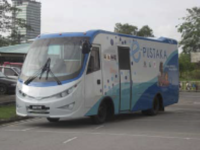E-Pustaka
e-Pustaka was a code name for Pustaka Negeri Sarawak Mobile Multimedia Library. Physically, it is a medium-sized bus equipped with the following basic ICT facilities:
 e-Pustaka Kuching |
a) a network server;
b) an IP-based local area network;
c) 8 - 10 units of computers;
d) a printer;
e) an Internet connection;
f) an electric power generator;
g) an air conditioning system; and
h) books and CD-ROM collection.
History
 e-Pustaka Sarikei |
Manned by 2 specially trained staff, e-Pustaka commenced its services in Kuching sub-urban areas in the year 2001. In 2004, another unit was added and commissioned in Limbang to serve the communities there. This unit was later shifted to Lawas to reach out to more users in the northern region of Sarawak.
2007 is the inaugural year for e-Pustaka to commence its service in Lawas district. e-Pustaka Lawas, which was initially e-Pustaka Limbang, worked effortlessly in providing multimedia and Internet services, beside delivering information literacy classes to primary schools in the outskirts of Lawas Town. Meanwhile in Kuching, e-Pustaka shifted its attention to communities in the rural district.
e-Pustaka Sarikei commenced its inaugural services in early May 2008. It served 7 primary schools in Sarikei town district. The schools or service points were visited 15 times on average. During each visit, about 4 information literacy classes were conducted. During the same year, e-Pustaka Kuching - the first mobile multimedia unit - was decommissioned due to its high maintenance cost.
Core Services
The core services of e-Pustaka were modular hands-on training sessions covering the following areas:
a) fundamentals of computers;
b) online information resources;
c) use of productivity tools; and
d) use fo the Internet.
Objectives
The main objectives of this service are:
a) to improve ICT awareness among the rural population;
b) to provide electronic classroom experience to the rural community;
c) to promote the use of ICT in teaching and learning at school level;
d) to assess the impact of ICT applications in the rural areas; and
e) to narrow the digital divide or gap among the communities in Sarawak.